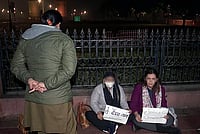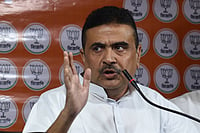At last, more than four decades after 1971, we have the first important international histories of the Bangladesh liberation war based on archival materials. Srinath Raghavan has delved widely into the archives of several countries to produce a ‘global history’. Gary Bass focuses on US and Indian policies. Both have made full use of the Indian records available in the Nehru Memorial Museum and Library as well as the recently declassified ministry of external affairs files housed in the National Archives.
Raghavan has produced a scholarly study couched in sparkling prose. He has a wide canvas, seeking not only to delineate the policies of the major international actors, including a number of middle powers, but also to situate the liberation struggle in the context of broader global historical processes. He is at his best as a diplomatic historian. The centrepiece of his book is a detailed, skilfully pieced together account of the evolution of Indian, US and Russian policies in 1971. He also captures in perfect cameos—brief but precise—the policies of UK, France, frg, gdr and Australia. He is less successful in grasping the deep historical roots of the Bangladesh movement. Partly as a consequence, his ambitious attempt to locate the liberation war within the context of global trends is not always convincing.
The narrative begins somewhat abruptly in 1969 with Ayub’s downfall, an event which Raghavan believes “was the critical turning point that led toward the road to Bangladesh”. In reality, the foundations of united Pakistan had become very shaky by then, leading RAW as well as US State Department analysts to question its survival. In February 1969, the director of intelligence and research in the State Department was already reporting that “secession cannot be ruled out”. In Raghavan’s account, by January 1971, “RAW had begun to receive inputs suggesting that Mujib considered secession to be a real possibility” [emphasis added]. In fact, such inputs were being received long before 1971. In 1966, Sheikh Mujibur Rahman told deputy high commissioner Asoke Ray that the six-point programme was intended as a bridge to independence.
However, coming to the events of 1971, Raghavan weaves together a compelling account of the evolution of Indian policy in a rapidly changing scene. He explains why, before the brutal military crackdown on March 25, the “possibility of secession by East Pakistan was recognised—only to be assessed as antithetical to India’s interests”. He punctures Manekshaw’s boast that he dissuaded Indira Gandhi from prematurely launching a military intervention. There is an excellent account of the origins of the Indo-Soviet Treaty and India’s diplomatic and military preparations to assist the liberation struggle. Raghavan provides conclusive evidence that India never had West Pakistan in its sights and that the CIA report to the contrary was fictitious.
There are some important omissions in Raghavan’s account. With the approach of the USS Enterprise, India requested Moscow to make a public announcement at the highest level, warning against involvement or interference by third countries. Raghavan states that Moscow “declined to make the announcement”. But he misses the fact that the Soviet leadership promptly sent a top-secret message to Nixon on these lines. They also ostentatiously enhanced their naval presence in the Indian Ocean. After his discussions with Zhou Enlai in July 1971, Kissinger came away with the impression that China would intervene in the event of an Indo-Pakistan war. Raghavan says this led Kissinger to misread the situation in December. In fact, Kissinger had radically revised his initial assessment after his October visit to Beijing. After the second visit, he reported to Nixon that China was now “afraid of giving Moscow a pretext for attack”. In December, Kissinger believed that China would not intervene unless it was offered an assurance of American support. This is why he proffered an assurance of support while encouraging China to move against India in December.
Raghavan’s book is intended as a ‘global history’. Venturing into largely unexplored territory, he raises a number of interesting questions but at times stretches the facts to fit them into his thesis. He exaggerates the impact on East Pakistan of student movements in Europe and the US and ’60s counterculture. “The counterculture of the Sixties found a fertile bed among Pakistani youngsters,” he asserts. “Rock ’n roll was an important vector for the global diffusion, including Pakistan, of the spirit of the Sixties.” He presents a startling thesis: “Without the global revolts of 1968, it is exceedingly unlikely that there would have been an uprising led by Pakistani students that not only deposed Ayub Khan but also radicalised the movement for autonomy in the eastern wing.” This is a far-fetched notion. The Bangladesh movement drew its inspiration from traditional Bengali culture, not an imported ‘counterculture’; from the songs of Tagore and Nazrul Islam, rather than rock ’n roll. The Bangladesh student movement was inspired by the martyrs of the Language Movement, not the colourful student leaders of Britain or France.
The American edition of Gary Bass’s The Blood Telegram carries the subtitle Nixon, Kissinger and a Forgotten Genocide. The subtitle of the Indian edition (India’s Secret War in East Pakistan), evidently intended to stimulate local sales, shifts the focus away from the principal theme. Bass, a Princeton University professor of political science, focuses on US and Indian policies and the humanitarian dimensions of the 1971 war. He writes in a vivid and racy style and never fails to hold the reader’s attention. The book is a thoroughly researched and damning indictment: “Nixon and Kissinger bear responsibility for a significant complicity in the slaughter of the Bengalis...this major incident has largely been whitewashed out of their legacy—and not by accident. Kissinger began telling demonstrable falsehoods about the administration’s record just two weeks into the crisis, and he has not stopped distorting since.”
Bass demolishes Kissinger’s defence of his stand on humanitarian issues, including the refugee problem and restoration of democracy. He shows that the few initiatives taken by the US administration were not only totally inadequate but were designed to deny India a valid justification for intervention. India receives qualified approval. Bass agrees that India’s military intervention was one of the most successful cases of humanitarian intervention against genocide but adds that “Indira Gandhi’s government was motivated by a mix of lofty principle and brutal realpolitik”. This is true, of course, but the reader may well ask whether there is even a single instance in history of a government undertaking humanitarian intervention without any concern for its national interest!
The hero of Bass’s book is Archer Blood, the US consul-general in Dhaka, whose detailed and unsparing reports of Pakistani atrocities earned him the displeasure of top US leaders. His cable of March 28, titled Selective Genocide, reported that he and his colleagues were “mute and horrified witnesses to a reign of terror by the Pak military”. “We should be expressing our shock, at least privately, to GOP,” he pleaded. Only to be answered by a deafening silence from Washington. In desperation, on April 6, Blood and nineteen of his colleagues signed a dissent cable declaring that US policy “serves neither our moral interests broadly defined nor our national interests narrowly defined”. Blood was fully aware that he was sacrificing a promising career but chose to maintain his integrity as a human being and Foreign Service officer.
Bass does not systematically address the other question raised in the Blood telegram—whether the Nixon-Kissinger policy served US national interests—but he offers a deeply perceptive observation: “For all his (Kissinger’s) commitment to dispassionate realpolitik, he seemed propelled almost as much by emotion as by calculation. He would not admit that the United States had missed opportunities to avoid war by pressurising Pakistan. Despite having spent months denying that the United States bore responsibility for Pakistan’s actions, he now wholeheartedly blamed the Soviet Union for India’s. Nixon, despite his visceral hatred of India, saw the bigger picture: this was just one crisis in just one part of the world, where the United States was playing a losing hand. But Kissinger, in his despondency and rage, kept trying to escalate. He wanted to force the Soviet Union to back down.”
This helps explode some myths propagated by Kissinger in his memoirs.
(Chandrashekhar Dasgupta is a former diplomat, and a columnist)


























